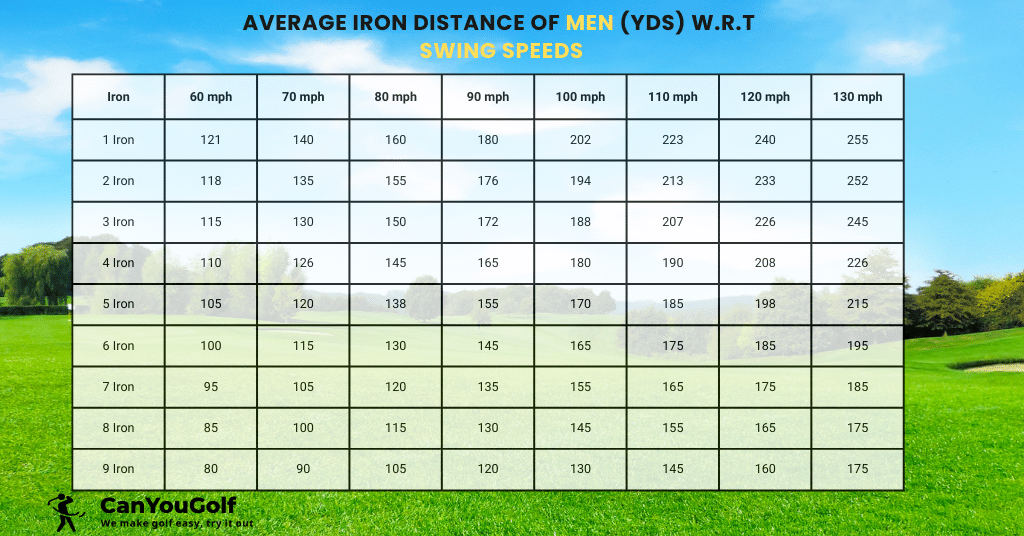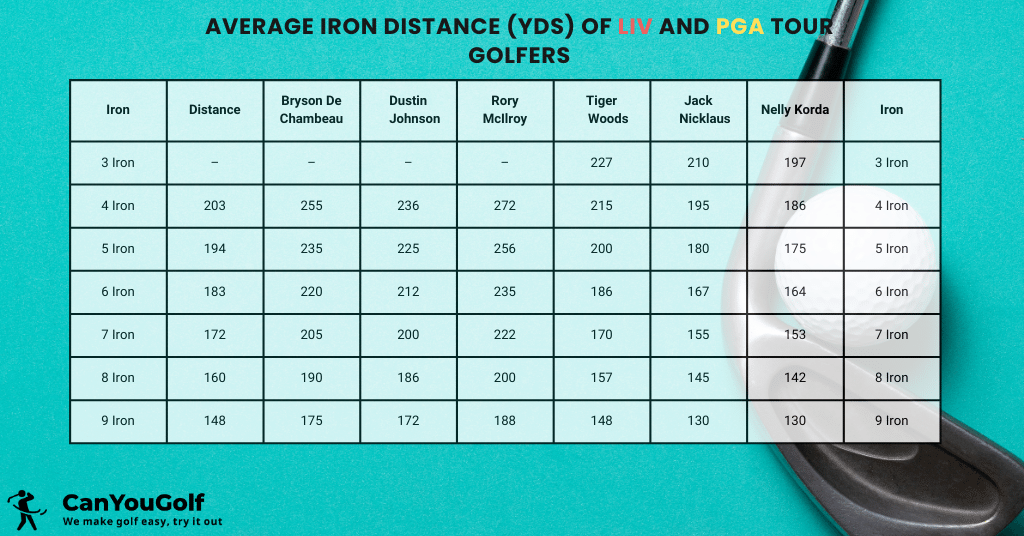One of the few key differences between average golfers and advanced golfers is the knowledge of their golf iron distance chart. Actions backed by data are effective in making progress.
- Why Do You Need an Iron Distance Chart?
- Key Factors and Statistics for Golf Club Distance Chart
- Iron Distance Chart for Men, Women, and Senior Golfers
- Average Iron Distance w.r.t. Swing Speed
- Average Iron Distance of LIV and PGA Golfers
- How Can You Get Your Iron Distance Chart?
- Practices to Increase Your Iron Distance
- People Also Ask
- Fina Words
In this blog, we will decode the golf iron distances chart w.r.t age, gender, and skill levels (golfer categories, average swing speed by golfer type, average swing speeds by age, distance charts for irons of men, women, seniors, LIV, and PGA Tour players).
Why Do You Need an Iron Distance Chart?
A PGA Tour player hits a 7-iron to 4 different distances and trajectories with partial swings by choice and command over the game. On the contrary, an average golfer hits it to 4 different distances and trajectories either accidentally or inconsistently.
This is why advanced golfers and pros have their golf iron distances measured.
It is equally important to have a golf club distance chart (driver, fairway woods, hybrids, and wedges) along with the iron distance chart. Improving your golf club distances is possible only when you know the average distance of your golf clubs.
Key Factors and Statistics for Golf Club Distance Chart
There are many factors at play in measuring accurate golf club distances. These are golfer types, age, gender, and skill sets in which swing speed is the most important in determining the average distance.
Let’s break down this pool of information into impactful pieces of knowledge.
Note: The following is vital in establishing our credibility.
Source: pgatour.com, lpga.com, trackman.com, and golfwrx.com
Measurement: All statistical data is measured as carry distance. It does not include rolling or total distance.
Golfer Types
We have categorized golfers into six segments with a set range of golf handicaps, rounds played, and time frames.

Golf Types and Relative Swing Speeds
The following table shows the average swing speeds for different segments of golfers. All speeds are measured for a 4-iron.


It is worth noting that the same swing speed of different golfer segments will not result in the same yardage distance. For example, an average golfer and an LPGA golfer have almost the same swing speed for the same club of 7 iron but their distances will vary based on other factors.
These factors are physical strength, muscle mass, biomechanics, technique, smash factor, equipment, and training and conditioning. Except for equipment, men have more favorable factors.
Average Swing Speed by Age (Beginners to Advance)
The following table shows the swing speed of six segments of golfers’ differentiated by age and gender. The lower-end values are for beginners and the higher-end values are for advanced players.


The difference between men’s and female swing speeds is mainly due to the eight factors mentioned above.
However, swing speed is still the most important factor in average distances. A moderate to high swing speed will increase golf club head speed and ball speed. If a beginner golfer has an in-built high swing speed, chances are he will out-drive his fellow golfers of the segment.
Iron Distance Chart for Men, Women, and Senior Golfers
Now let’s talk about the Iron Club distance chart. The following chart will include the distance for different segments of golfers with the same clubs.
Along with irons, we have added pitching wedge, gap wedge, sand wedge, and lob wedge statistical data.
Iron Distance Chart for Men
We start with men’s average distances for irons. All the following data is collected for full swings. For the relative segment, expect your iron distances to match the table. If the distances are low, you will need to up your golf game.
We will share effective practices to improve iron distance later in the blog.


As you can see in the chart, beginners, average, and intermediate golfers struggle with longer golf irons that have low loft.
For longer irons, this gap in the yardage is huge. As the lofts increase, the gap in the achievable distance also reduces. Short-hitter golfers struggle with driver swing speed and consistent golf club distance.
A beginner will hit a 5-iron for 130 yards whereas an advanced golfer will hit it for 195 yards. There is a difference of 65 yards for the same golf club.
Iron Distance Chart for Women
We have done the same for the iron distance chart for women golfers. In the following chart, you will see a similar gap in average distances. The handicap range of women golfers is higher than men. So the beginner range will have 28+ handicap golfers segment.


The data from 1 to 5 irons is missing because women golfers don’t use the driving and long irons. They cover the initial yardage of any hole by hitting a driver.
Secondly, most women’s golf sets are offered from 6 iron to 9 iron.
The golf club distance is similar to men golfers. A beginner woman golfer hits a 5 iron to 70 yards and an advanced woman golfer carries 130 yards. There is a difference of 60 yards.
Iron Distance Chart for Senior Golfers (Men and Women)
Next up, we have data on senior golfers. As golfers age, though their skill level increases, their swing speed decreases. This reduces the average distance. If a senior’s golf club distance is +/- 5 yards from the table below, they are doing good.


If you are playing for a good time, there is no need to stress about the distances unless you are a Tiger Woods prodigy. Take a full swing, hit each club, and have fun on the golf course.
Average Iron Distance w.r.t. Swing Speed
To make things simpler, we have made an iron distance chart relative to the swing speed We have included 60 mph, which is an absolute starting point for any golfer. The higher end is 130 mph, which is unrealistic except for the Long Drive Competition participants.
Most of the PGA Tour players hit between 110-120 mph and most amateurs hit the long clubs with 90-100 mph.


Average Iron Distance of LIV and PGA Golfers
We have already talked about the PGA golfers and their average iron distances. Let’s talk about some of the greats of the golf game and see where they stand on the iron distance chart.
Our list has the following golfers:
Bryson De Chambeau, Dustin Johnson, Rory McIlroy, Tiger Woods, Jack Nicklaus, and Nelly Korda.


There is an interesting analysis in this iron distance chart. By comparing the distances of Jack Nicklaus and Nelly Korda, you will find them to be almost similar. Even the gender difference could not make much of a difference. Why is that?
That’s the equipment advancement. This is the impact of the latest golf clubs.
How Can You Get Your Iron Distance Chart?
Decoding your distances begins with obtaining an accurate Iron Distance Chart. Crucial information for refining your game that provides insights into club selection and shot strategy.
To build your chart, consider investing time at a reputable driving range equipped with a launch monitor. These devices precisely measure key metrics like ball speed, launch angle, and spin rate, providing invaluable data for accurate distance calculations.
You can also buy a personal mobile launch monitor such as Rapsodo MLM 2 Pro and get the most accurate information.
Repeatedly hit shots with each iron (partial swing, half swing, and full swing), ensuring a stable swing and contact. This routine not only hones your skills but also generates reliable data for your distance chart. Aiming for the ideal conditions, like a calm day without excessive wind, ensures your recorded distances accurately reflect your capabilities.
Regularly updating your Iron Distance Chart is vital for tracking improvements and adjusting strategies. Revisit the driving range to reassess your distances, especially after any swing modifications or equipment changes.
By incorporating Launch Monitor data and adhering to consistent practice, you’ll develop a reliable chart that enhances your decision-making on the course, ultimately elevating your golfing experience.
Record the Data
Once you have all the data, record it on any mobile golf app or make a chart on paper and keep it with yourself whenever you play a round.
Practices to Increase Your Iron Distance
Who does not want to improve their golf iron distance? Follow the following 5 points and practice consistently.
| Swing Mechanics | Efficient swing mechanics play a pivotal role in maximizing iron distance. Work on a smooth, controlled swing with proper weight transfer, allowing for optimal power generation and impact. |
| Club head Speed | Increasing clubhead speed translates directly to more distance. Engage in exercises and drills that enhance your overall strength and flexibility, enabling you to generate greater speed through the impact zone. |
| Consistent Ball Striking | Achieving a consistent strike on the sweet spot of the clubface is vital for distance gains. Regular practice and refining your technique contribute to a more precise and powerful impact. |
| Proper Equipment | Ensure your irons are suited to your swing and skill level. Custom-fitted clubs, the right shaft flex, and loft adjustments can significantly impact both accuracy and distance. |
| Fitness and Conditioning | A well-conditioned body contributes to a more powerful swing. Incorporate strength and flexibility exercises into your fitness routine, focusing on the core, legs, and rotational movements to enhance your overall golf performance. By addressing these key aspects, you’ll be on the path to improving your iron distance and elevating your game. |
People Also Ask
How Does Elevation Affect Golf Iron Distances?
Elevation affects air density, reducing resistance. At higher altitudes, golf balls experience less drag, resulting in increased distance.
What Role Does Humidity Play in Golf Iron Distances?
Humidity affects air density, influencing ball flight. Higher humidity creates denser air, potentially causing increased drag and shorter distances.
Is There an Ideal Temperature for Maximizing Golf Iron Distances?
There is no strict ideal temperature, but warmer conditions generally provide better ball compression. Cold air is denser, potentially reducing ball flight.
Do Golf Iron Distances Change on Different Types of Grass?
Grass type influences club interaction with the ball. Tighter fairways may yield more roll, while thicker rough can impede distance.
What is the average distance of 7 iron?
The average distance of a 7 iron for men is 150-165 yards and 100-115 yards for women.
What are carry distance and total distance in golf?
Carry distance is the total air distance of the golf ball before it bounces whereas total distance is the distance from where the shot was played to the point where the golf ball stops after rolling.
Fina Words
Proper knowledge of distance plays an important role in improving the overall game performance of a golfer. This iron chart distance is an indication of how long you should your irons. Keep this iron distance chart as a check mark to achieve distance.





